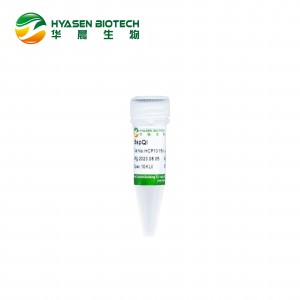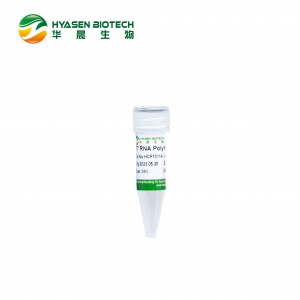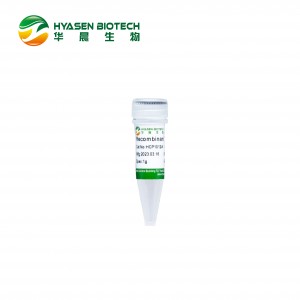
Hi-yield T7 in vitro transcription reagent (Thermostable)
Hi-yield T7 in vitro transcription reagent kit (Thermostable) is capable of in vitro transcription at higher temperatures up to 50°C. The kit is capable of synthesizing high yield RNA transcripts using linear double-stranded DNA containing T7 promoter as template and NTPs as substrate. The kit is suitable for incorporation of modified nucleotides to obtain biotin labeled, dye labeled and radiolabeled RNA. The kit also can be applied in synthesis of co-transcriptionally capping mRNAs with cap analogs. The kit contains modified nucleotides N1-Me-pUTP as alternative.
Each standard reaction yields up to 150-200 μg of RNA from 1μg DNA template. Reaction size can be scaled up to yield milligram-level RNA as needed.
RNA synthesized from the kit is suitable for many applications including RNA structure and function studies, ribozyme biochemistry, RNase protection assays and hybridization-based blots, anti-sense RNA and RNAi experiment. RNA synthesized from the kit also is suitable for producing enzymatic production of capped RNA by vaccinia capping enzyme and 2’-O-Methyltransferase and being tailed up with Poly(A) polymerase to improve the stability and translational competence of RNA used for in vitro translation, transfection, and microinjection.
Components
|
Component |
Concentration |
Volume |
|
ATP |
100 mM |
100 μL |
|
CTP |
100 mM |
100 μL |
|
GTP |
100 mM |
100 μL |
|
UTP |
100 mM |
100 μL |
|
N1-Me-pUTP |
100 mM |
100 μL |
|
10 × Hi-Yield IVT Buffer A |
/ |
100 μL |
|
Enzyme mix (Thermostable) |
/ |
100 μL |
Storage conditions
Transportation under 0°C and storage at -25~- 15°C.
Protocal
•DNA template preparation
Linearized plasmid DNA, PCR products or synthetic DNA oligonucleotides can be used as templates for in vitro transcription with the kit.The DNA template can be dissolved in TE buffer or RNase-free ddH2O.
• Plasmid templates: The linearized plasmid must contain a T7 promoter region as DNA template. The quality of the linearized plasmid affects the yield and integrity of RNA. Completely linearized plasmid template of highest purity is critical for successful use of the kit because circular plasmid is not effectively terminated. The highest transcription yield is achieved with the highest purity template. To produce RNA transcript of a defined length, plasmid DNA must be completely linearized with a restriction enzyme that generate blunt ends or 5’-overhangs. The linearized plasmid purified by laboratory methods can be free from contaminating RNase, protein, RNA and salts.
• PCR templates: PCR products containing T7 RNA polymerase promoter in the correct orientation can be transcribed. Better yields will be obtained with purified PCR products, though PCR mixtures can be used directly.
•Synthetic DNA oligonucleotides:Synthetic DNA oligonucleotides which are either entirely double-stranded or mostly single-stranded with a double-stranded T7 promoter sequence can be transcribed
RNA Synthesis Protocols
Wearing gloves and using nuclease-free tubes and reagents to avoid RNase contamination are strongly recommended. Reactions of small volume should be assembled in nuclease-free microfuge tubes or PCR strip tubes.
Conventional RNA Synthesis
1.Thaw the necessary kit components, mix and pulse-spin in microfuge to collect solutions to bottom of tubes. Keep on ice.
2.If you are planning to run many reactions, it is convenient to prepare a master mix by combining equal volumes of the 10× Hi-Yield IVT Buffer and four ribonucleotide (NTP) solutions. Use 10 µl master mix per reaction.
3. Assemble the reaction at room temperature in the following order:
|
Reagent |
Amount |
|
Nuclease-free water |
X μL |
|
10 × Hi-Yield IVT Buffer A |
2 μL |
|
ATP/CTP/GTP/UTP *(100 mM each) |
2 μL each(10 mM each Final) |
|
Template DNA |
Y μL (1 μg) |
|
Enzyme mix (Thermostable) |
2 μL |
|
Total Reaction Volume |
20 μL |
* To reduce the product’s immunogenicity, UTP can be replaced by N1-Me-pUTP at the same final concentration.
4. Mix thoroughly, pulse-spin in microfuge. Incubate at 37°C for 2 hours, or 50 °C for 1 hour if high temperature reaction is required.
5. DNA Digestion: To remove template DNA, add 10U of DNase I to each 20 μL reaction, mix well and incubate at 37℃ for 30 minutes.
Capped RNA Synthesis
Similar protocol to conventional RNA synthesis, except for the step of assembling the reaction. Assemble the reaction of capped RNA synthesis at room temperature in the following order:
|
Reagent |
Amount |
|
Nuclease-free water |
X μL |
|
10 × Hi-Yield IVT Buffer A |
2 μL |
|
ATP/CTP/GTP/UTP *(100 mM each) |
2 μL each (10 mM each Final) |
|
Cap analog (100 mM) |
1.6 μL |
|
Template DNA |
Y μL (1 μg) |
|
Enzyme mix (Thermostable) |
2 μL |
|
Total Reaction Volume |
20 μL |
*** If required, Cap1(3’OH AG) and cap1(3’OMe AG) can be used ascap analogs. Werecommend our co-transcription reagent Co-capping T7 invitro transcription reagent (pUTP, CAP GAG (3’OMe) , pUTP, CAP GAG, N1-Me- pUTP, CAP GAG (3’OMe) and N1-Me-pUTP, CAP GAG.
mRNA purification
• Phenol: Chloroform Extraction and Ethanol Precipitation
For removal of proteins and most of the free nucleotides, phenol: chloroform extraction and ethanol precipitation of RNA transcripts is the preferred method.
1.Adjust the reaction volume to 180 μLby adding 160 μL nuclease-free water. Add 20 μL of 3M sodium acetate, pH5.2, mix thoroughly.
2. Extract with an equal volume of 1:1 phenol/ chloroform mixture, centrifuge at 10000 rpm for 5 minutes. Collect the aqueous phase and transfer to anew tube.
3. Followed by two extractions with an equal volume of chloroform. Collect the aqueous phase and transfer to a new tube.
4. The RNA was precipitated with 2 volumes of ethanol. Incubate at -20℃ for at least 30 minutes, and the collect the pallet by centrifugation for 15 minutes. Carefully remove the supernatant.
5. Rinse the pallet with 150 μL~200 μL cold 70% ethanol.
6. Air dry the pallet for 2 minutes and resuspend in 100 μL~200 μL RNase-free water or other buffers.
• LiCl precipitation
LiCl precipitation of RNA is effective at removing the majority of unincorporated NTPs and enzymes.
1. Add an equal volume of LiCl solution (5M), mix well.
2. Incubate at -20℃ for at least 30 minutes. Centrifuge at 4℃ at 12000 rpm for 15 minutes to pallet RNA. Carefully remove the supernatant.
3. Resin the pallet by adding 200 μL of precooling 70% ethanol. Carefully remove the ethanol. Repeat the steps for 2~3 times.
4. Air dry the pallet for 5~10 minutes and resuspend in 100 μL~200 μL RNase-free water or other buffers.
• Spin column purification
Spin columns will remove unincorporated NTPs, proteins and salts.
• Magnetic bead purification
Magnetic bead purification can remove unincorporated nucleotides, proteins and salts.
Quantification of reaction products
• Quantification by UV light absorbance: The reaction products need purification because any unincorporated nucleotides and template DNA in the reaction mixtures will affect the reading. Measuring the UV spectrophotometry at 260 nm can easily obtain RNA concentration. For single- stranded RNA, 1 A260 corresponds to RNA concentration of 40 μg/mL.
• Quantification by dye: Quantification of the reaction products can used with Ribogreen dye without purification because unincorporated nucleotides will not affect evaluation of RNA products.
Notes
• The transcription reaction should be performed in RNase-free environment. Wearing gloves is advisable. The tips, tubes and water should be nuclease-free.
• All optimal final concentration of NTPs is 10 mM, and you can change the final concentration of NTPs according to actual state.
• The RNA synthesis reaction mixture should be prepared at room temperature, since DNA may precipitate in the presence of spermidine at 4°C.
• The yield of proper length transcripts decreases if the template DNA is incompletely linearized.
• The reaction mixture can be scaled up or down.
• Mix the buffer until the insoluble substances are completely dissolved before use, if the buffer is found to have insoluble substances after remelting.
• For reactions with transcripts shorter than 300 bp, 4-8 h incubation at 37 ℃ should give you higher yield。
• The DNA template used for standard RNA synthesis transcripts should contain a T7 promoter sequence followed by GGG initiation sequence, because T7 RNA polymerase has higher affinity of GTP.
• The DNA template used for the mRNA synthesis with co-transcription system should contain a T7 promoter sequence followed by AGG initiation sequence.
Troubleshooting
a) Low yield of full-length RNA:
If the transcription reaction generates full-length RNA, but the yield is significantly lower than expected, it is possible that contaminants in the DNA template are inhibiting the RNA polymerase, or the DNA concentration may be too low or incorrect.
Suggestion: Additional purification of the DNA template is recommended.
b) RNA transcript smearing on denaturing Gel:
If the RNA appears degraded on denaturing agarose or polyacrylamide gel, DNA template or experiment process is contaminated with RNase.
Suggestion: If the plasmid DNA template is contaminated with RNase, perform phenol/ chloroform extraction and ethanol precipitate. Assure tips and tubes used during the experiment are RNase-free. Please wear lab coat, mask and disposable gloves.
c) RNA transcript of larger size than expected:
If the RNA transcript appears larger than expected on a denaturing gel, template plasmid DNA may be incompletely digested. The presence of strong secondary structures can cause the RNA transcript not completely denatured.
Suggestion: Check template for complete digestion, if undigested plasmid is confirmed, repeat restriction enzyme digestion. Reduce secondary structures of DNA template at the stage of sequence design.
d) RNA transcript of smaller size than expected:
If denaturing gel analysis shows the presence of smaller bands than the expected size, it is most likely due to premature termination by the polymerase. Some sequences which resemble T7 RNA polymerase termination signals will cause premature termination.
Suggestion: Incubating the transcription reaction at lower temperatures, for example at 30°C, may increase the proportion of the full-length transcript, however the yield will be reduced. For GC rich templates, or templates with secondary structures, incubation at 42°C may improve yield of full-length transcript.














